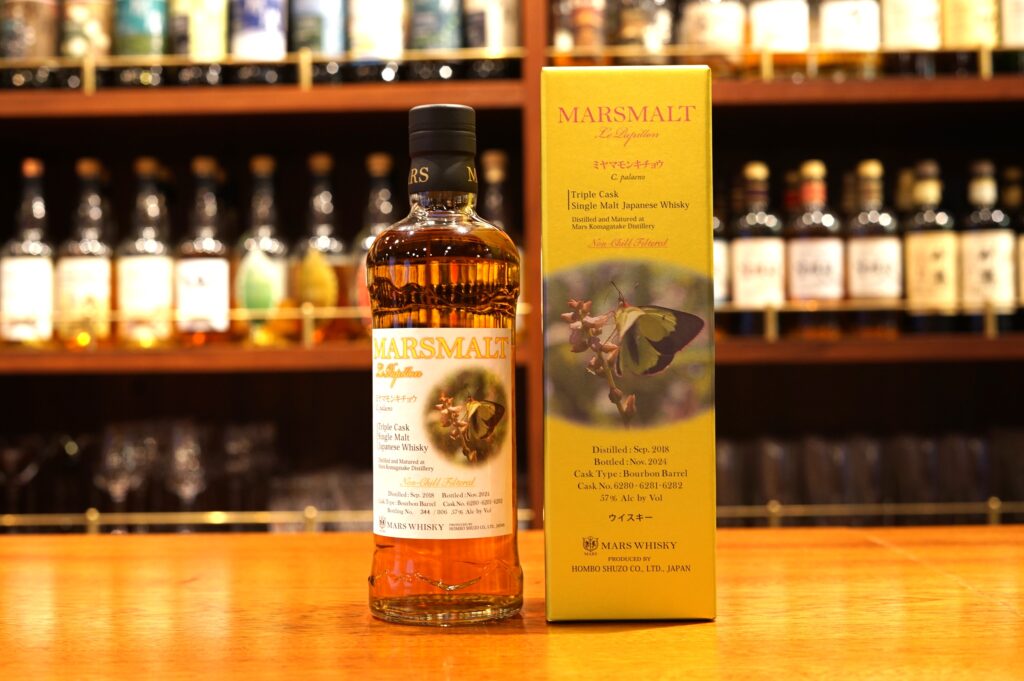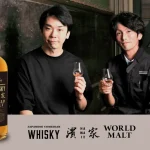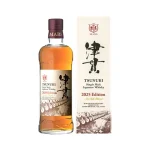Papillon series from Honbo Brewery. Mars Malt Le Papillon Triple Cask“Miyamamonkicho”,features, price and how to buy.
With a label featuring a picture of a butterfly, many whisky lovers may recognize it. Mars Malt Le Papillon” series. Many varieties have been released so far.
This time, the 18th release in the Papillon series, Mars Malt Le Papillon Triple Cask “Miyamamonkicho” (released in December 2024), was released.
The number of bottles in this series is small each time, but this time there are 806 bottles of the triple cask. There is no doubt that it will be difficult to obtain.
1. photo of the bottle and label
Mars Malt Le Papillon Triple Cask “Miyamamonkicho
MARS MALT Le Papillon Triple Cask C.palaeno





Characteristics of Le Papillon Miyamamonkicho
This is the 18th release in the Papillon series and is made from three barrels of malt distilled at the Mars Komagatake distillery in 2018 and aged in bourbon barrels.
Mars Malt Le Papillon” is a series that uses butterflies that inhabit Japan as a motif to express the splendor of Japan’s four seasons and its natural environment, which forms the environment in which whisky is matured.
The theme of this product is the “Miyama Monk butterfly,” which inhabits the alpine zone in central Honshu, and this product is a gem of a triple cask single malt whisky with the image of a noble figure with its wings framed in a fresh peach color, distilled at the Mars Komagatake distillery, and vatted from three barrels matured in bourbon barrels.
<The Miyamamonkicho, a beautiful species that Japan is proud of, is a member of the alpine butterfly family that inhabits the alpine zone of Shinshu. Its whole body is bordered with dark pink, giving it a stylish and graceful appearance. I first encountered this butterfly in July 1973 at the summit of Mount Neko in the Asama Mountains of Shinshu. Climbing the mountain in the blistering heat was a struggle, and I was exhausted by the time I reached the summit. A small butterfly was flying at breakneck speed just above the debris field, just beyond the forest line. I was amazed at how fast they could fly! I had assumed that they flew in a graceful dance. This triple cask single malt whisky, which evokes the “elegance of alpine butterflies,” was distilled at the Mars Komagatake distillery in 2018 and vatted with three barrels of malt distilled at the distillery and aged in bourbon barrels. Label photo and text by Shuichi Ogino.
2-1. Tasting Notes
| Aroma | Juicy peach, pineapple, citrus syrup, honey, vanilla essence |
| Taste | Peach compote, vanilla ice cream, lemon candy, ginger |
| Aftertaste | Sour sweetness like juicy fruit, lingering spiciness |
2-2. Product Specifications
 |
 |
| Alcohol content | 57% (with a minimum of 5% alcohol by volume) |
| alcohol category | Single malt Japanese whisky |
| Barrel type | Bourbon Barrel |
| Content volume | 700ml |
| Number of bottles sold | 806 bottles |
| Suggested retail price | 15,400 yen (tax included) |
| Release date | December 2024 |
3. Awards
No awards received at this time.
4. Price
4-1. Manufacturer’s Suggested Retail Price
| Product name | Mars Malt Le Papillon Triple Cask “Miyamamonkicho |
| Capacity | 700ml |
| Suggested Retail Price | Tax included: 15,400 yen |
4₋2. Resale price on Mercari
Resale price on Mercari is about 39,000-43,000 yen. (*As of 12/25/2024)
4-3. Yahoo Auction Sold Price
No listings were confirmed on Yahoo! A uctions. (as of 12/25/2024).
4-4. Rakuten, Yahoo Shopping, Amazon
No items are currently listed on mail order sites. (as of 2024/12/25).
4-5. Price offered at BAR Shinkai
At BAR Shinkai, which is operated by this site, we offer small quantities such as 1 cup, 45ml: 4,620 yen 30ml: 3,080 yen, 15ml: 1,540 yen, etc.

5. About Mars Malt Le Papillon Series
The “Mars Malt Le Papillon” series expresses the splendor of Japan’s seasonal climate and natural environment, which forms the environment in which whisky is matured, using butterflies that live in Japan as a motif.
| No | Product name | Cask | Number of bottlings | Price (tax included) |
| Vol. 1 | Ooruri Shijimi | American White Oak | 599 bottles | 10,450 yen |
| Vol. 2 | Ae. aegypti | Bourbon barrel | 215 bottles | 9,900 yen |
| Vol. 3 | Reverdin’s Blue | American White Oak | 585 pieces | 9,900 yen |
| Vol. 4 | Tsumabenicho | Bourbon barrel | 182 bottles | 12,100 yen |
| Vol. 5 | Reverdin’s Crow Swallowtail *[WWA Gold Award]. |
American White Oak | 560 pieces | 11,000 yen |
| Vol. 6 | Ishigakecho | Sherry cask | 464 bottles | 11,000 yen |
| Vol. 7 | Giffen goose | American White Oak | 576 pieces | 13,200 yen |
| Vol. 8 | Yakushi Maruri Shijimi | Bourbon barrel | 469 bottles | 12,100 yen |
| Vol. 9 | Kumomatsumaki butterfly | Sherry Butt | 643 pieces | 12,100 yen |
| Vol. 10 | Peacock Butterfly *[ WWACategory Winner |
Sherry Bat | 635 pcs. | 12,100 yen |
| Vol. 11 | Monkey Swallowtail | Bourbon Barrel | 433 bottles | 11,000 yen |
| Vol. 12 | Mars Malt Le Papillon, Takahide Komatsu Edition | American White Oak | 365 bottles | 297,000 yen |
| Vol. 13 | Ainomidori Shijimi | Umeshu (plum wine) barrel | 567 bottles | 13,200 yen |
| Vol. 14 | Hime Shirocho | Bourbon cherry head cask | 567 bottles | 12,100 yen |
| Vol. 15 | Reverdin’s Blue | Sherry cask | 818 bottles | 14,300 yen |
| Vol. 16 | Nagasaki-agehara (Ligustrum japonicum) | Sherry cask | 621 bottles | 15,400 yen |
| Vol. 17 | Loomis Blue Whale | Bourbon Barrel | 578 bottles | 15,400 yen |
| Vol. 18 | Reverdin’s Blue | Bourbon Barrel | 806 bottles | 15,400 yen |
All of this series are bottled in small quantities, such as single or double cask, so the limited number of bottles each time is very small, making it one of the rarest and most scarce Japanese whiskies.
Click here for product details and past series.
6. Manufacturer
| Company name | Hombo Shuzo Co. |
| Established | 1872 |
| Head office location | 891-0122; 3-27 Minamiei, Kagoshima City, Kagoshima Prefecture |
| Owned distilleries | Mars Shinshu distillery, Mars Tsunuki distillery |
| Name of distillery | Komagatake distillery |
| Location | 4752-31 Miyata-mura, Kamiina-gun, Nagano 399-4301 |
| Start of operation | 1985 |
In 1949, Hombo Shuzo, which had been striving to make shochu, a Japanese distilled spirit, in Kagoshima, obtained a license to produce whisky. Since then, the company has held on to the dream of “someday making real whisky that makes the most of the Japanese climate.
After several years of whisky production in Kagoshima, in 1960, he established the Mars Yamanashi Winery, a factory for wine and whisky production in Yamanashi. Then, in order to engage in whisky production in earnest, he searched for an even more ideal location.
The natural conditions for whisky making are very demanding: a cold region with clear air, and blessed with moderate humidity and good quality water.
In 1985, after searching for land that met these conditions, Mars Shinshu Distillery was established at an altitude of 798 meters at the foot of Komagatake Mountain in the Central Alps, Nagano Prefecture, in search of the best environment for whisky making.

In 1992, distillation was halted due to sluggish demand for whisky. In 2009, when demand for Japanese whis key was recovering and Japanese whisky was gaining worldwide recognition, we decided to resume distilling and started again in February 2011.
In September 2020, the distillery was completely renovated for the first time in 35 years. The investment will be approximately 1.2 billion yen.
From May 2019, a new whisky distillation building (including a barrel cellar) and a new visitor building will be constructed for the purpose of renovating aging facilities, improving the barrel cellar facilities with a view to increasing whisky production, and providing tours of the whisky making process, as well as selling original whisky and other goods.


The new whisky distillation building, with a total floor area of 1,996m2 (including the barrel cellar, which will hold approximately 2,500 barrels), and the visitor’s building, with a total floor area of 746m2, were constructed by renovating existing equipment and facilities.
From March 1, 2024, the distillery name will be changed from “Mars Shinshu Distillery” to “Mars Komagatake Distillery” in order to unify the single malt whisky brand “Komagatake”.
Reference: Hombo Shuzo official website
Production capacity: 1.1 tons of malt/day
Production volume of sake: approx. 700L/day, approx. 185KL/year (planned for FY2020)
Main facilities: 1 malt crusher, 1 mash tun reuter (saccharification tank) 6KL, 3 stainless steel fermentation tanks 6KL, 3 Douglas fir wooden fermentation tanks (relocated) 6KL, first distillation kettle (relocated)




For more information about Komagatake Distillery, please see here.
Please also check out other articles about Hombo Brewery and Papillon series.
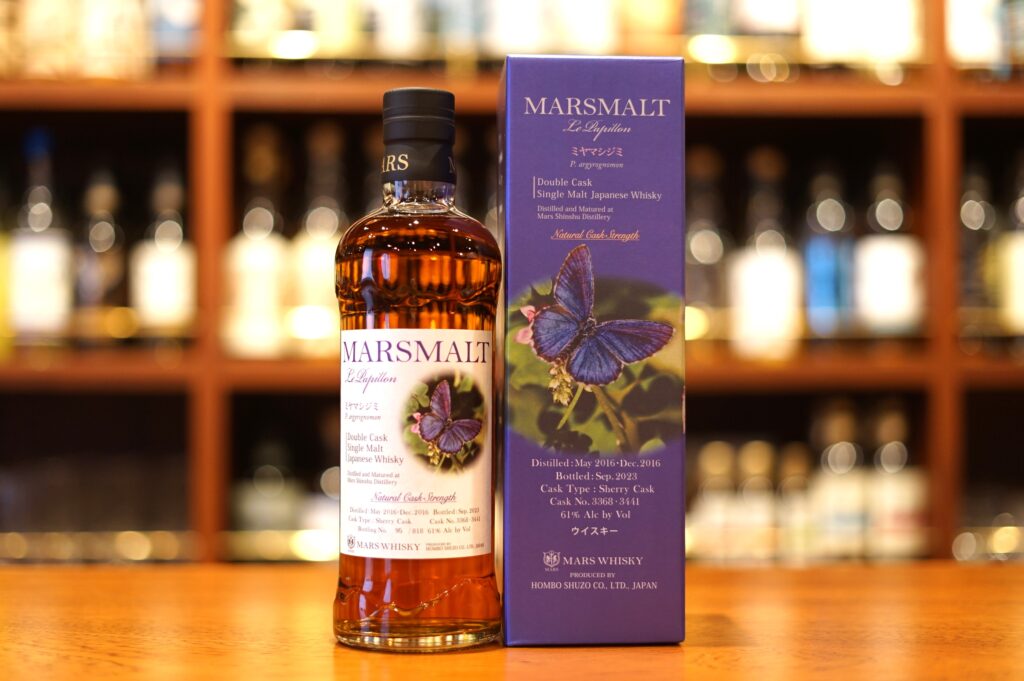
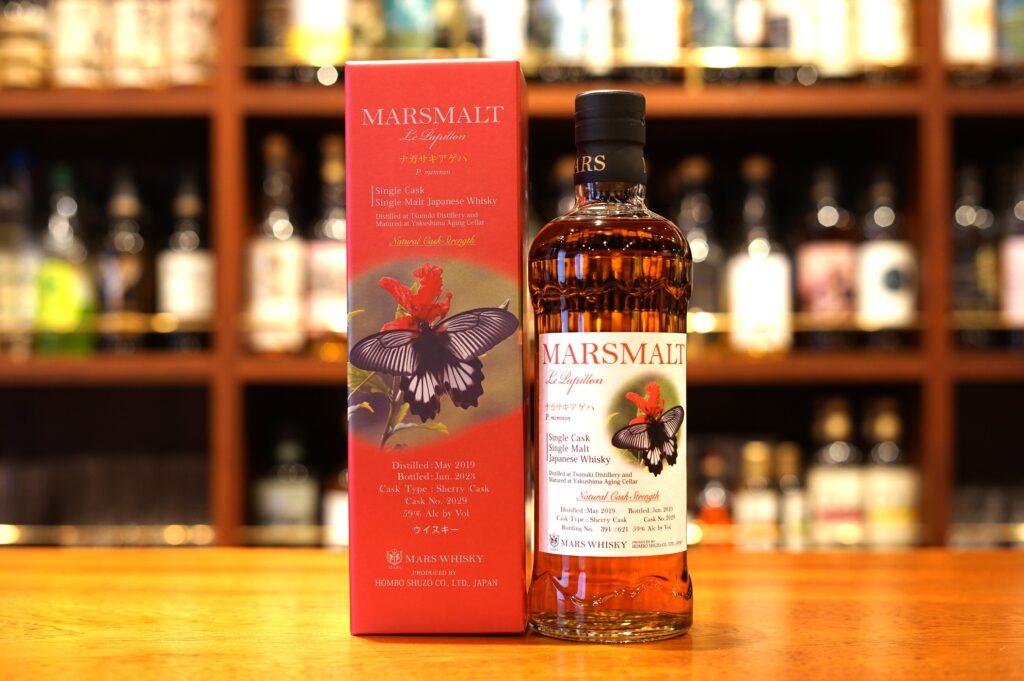
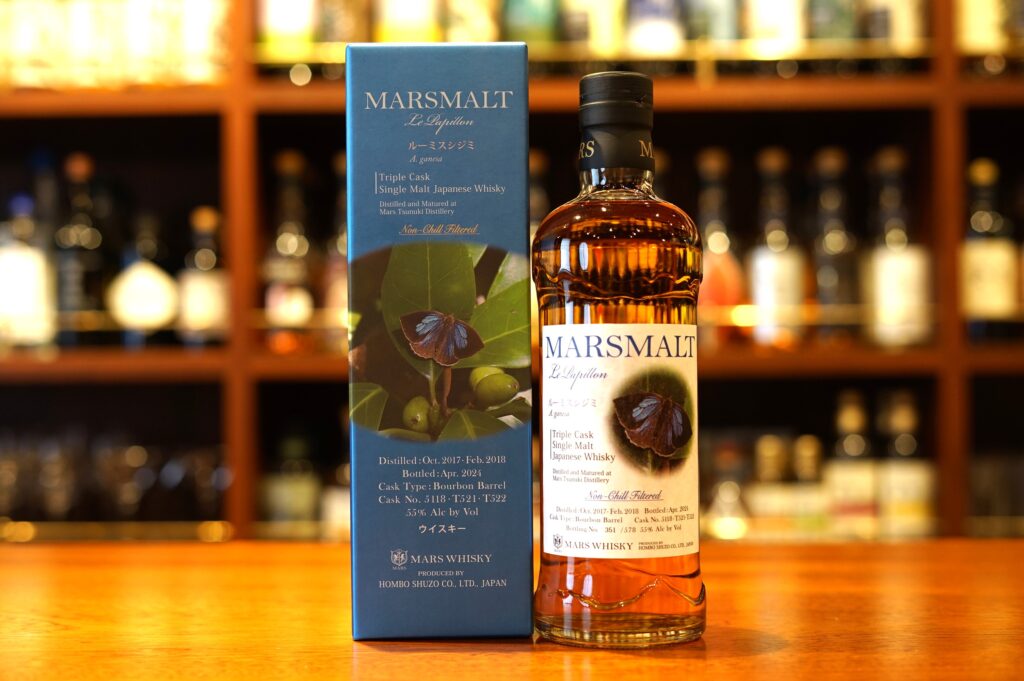
7. Summary
This year’s Papillon series was triple casked using only Komagatake sake. The cask numbers are sequentially numbered and casked at about the same time, and they have been aged for nearly 6 years. There is no indication that anything from the Yakushima aging cellar was used, but it is quite juicy and has a yellow fruit finish.
Please enjoy this new version, which shows a different aspect from the usual Komagatake.
Lastly: Recommended Books on Japanese Whisky
If you want to learn more about Japanese whisky, which is a global trend, we highly recommend these books.
(1).Whisky Galore Vol.29 December 2021 issue
In the December 2021 issue of Whisky Galore, published by the Whisky Culture Research Institute, we report on 11 Japanese craft distilleries, including some that are open to the public for the first time, under the title of “Japanese Whisky Craft Frontline,” the first of three consecutive issues. Why did the popularity of Japanese whisky and the craft boom occur? We will examine with interviews. Chichibu Distillery / Chichibu No.2 Distillery / Mars Shinshu Distillery / Mars Tsunuki Distillery / Kanosuke Distillery / Hioki Distillery / Ontake Distillery / Osuzuyama Distillery / Kaikyo Distillery / Hanyu Distillery / Konosu Distillery
(2). Japanese Whisky as an Education for Business
This is a book written by Mamoru Tsuchiya, a world-famous whisky critic and representative of the Whisky Culture Research Institute, titled “Japanese Whisky as a Culture that Works for Business” .
The book covers the basics of whisky, the introduction of whisky to Japan, the birth of Japanese whisky, advertising strategies and the rise of Japanese whisky, and the current rise of craft distilleries. This is a book that summarizes Japanese whisky in a very easy to understand way.
(3). Whisky and I (Masataka Taketsuru)
Masataka Taketsuru, the founder of Nikka Whisky, devoted his life to brewing whisky in Japan. This is a revised and reprinted version of the autobiography of a man who simply loved whisky and talked about himself. The book vividly depicts the days when he went to Scotland alone to study as a young man and overcame many hardships to complete Japanese whisky, as well as his companion, Rita.
(4). A Letter of Challenge from a New Generation Distillery
Launching in 2019. With the world experiencing an unprecedented whisky boom, what were the managers of craft distilleries thinking and what were their thoughts as they took on the challenge of making whisky? This book tells the stories of 13 craft distillery owners, including Ichiro Hido of Venture Whisky, famous for his Ichirose Malt, who inspired the birth of craft distilleries in Japan.
(5). Whiskey Rising
This is the Japanese version of Whisky Risng, published in the US in 2016, with much updated content. Not only does it describe the history of Japanese whisky in detail, but it also includes data on all the distilleries in Japan, including the craft distilleries that have been founded in recent years. The book also includes descriptions of the legendary bottles that have been released, as well as information on bars where Japanese whisky can be found.

